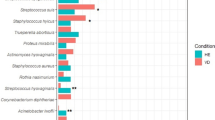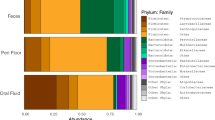Abstract
In this work, we describe the biodiversity of cloacal and pharynx culture-based bacteria (commensal and pathogenic), in 75 Eurasian griffon vultures (Gyps fulvus) from two geographic areas. We address the question of whether the cultivable microbiota of vultures is organised into assemblages occurring by chance. In addition, we assess bacterial diversity in both anatomic regions and geographic areas. Bacterial diversity was represented by 26 Gram-negative and 20 Gram-positive genera. The most common genera were Escherichia, Enterococcus, Staphylococcus, Clostridium and Lactococcus. Escherichia coli and Enterococcus faecalis were the most common species in cloacal and pharyngeal samples. Staphylococcus and Erysipelothrix were isolated from the pharynx and Salmonella and Corynebacterium from the cloacae, and no Campylobacter was isolated from the cloacal swabs. Ten cloacal swabs were positive for Salmonella, of which five isolates were Salmonella enterica serotype 4,(5),12:i:-, one isolate was S. enterica serotype Derby, three isolates were S. enterica serotype 61:k:1,5,7 and one isolate was S. enterica serotype Infantis. The null modelling approach revealed that the commensal bacteria of vultures are not structured in assemblages. On the other hand, differences in bacterial genus and species richness between cloacal and pharyngeal samples or between geographic areas were clear, with the pharynx in vultures from both geographic areas being richer. The results of this study indicate also that vultures can serve as a reservoir of certain pathogenic zoonotic bacteria. The dissemination of these zoonotic pathogens in wildlife could be prevented by periodic sanitary surveys.

Similar content being viewed by others
References
Álvarez-Fernández E, Alonso-Calleja C, García-Fernández C, Capita R (2012) Prevalence and antimicrobial resistance of Salmonella serotypes isolated from poultry in Spain: comparison between 1993 and 2006. Int J Food Microbiol 53:281–287
Amo K (2012) Salmonella. Nihon Rinsho 70:1348–3151
Bangert RL, Ward ACS, Staube EH, Cho BR, Widders PR (1988) A survey of the aerobic bacteria in the feces of captive raptors. Avian Dis 32:53–62
Barrow PA, Jones MA, Smith AL, Wigley P (2012) The long view: Salmonella—the last forty years. Avian Pathol 41:413–20
Brittingham MC, Temple SA, Duncan RM (1985) A survey of the prevalence of selected bacteria in wild birds. J Wildl Dis 24:299–307
Broman T, Palmgren H, Bergström S, Sellin M, Waldenström J, Danielsson-Tham M-L, Olsen B (2002) Campylobacter jejuni in black-headed gulls (Larus ridibundus): prevalence, genotypes, and influence on C. jejuni epidemiology. J Clin Microbiol 40:4594–4602
Burnham KP, Anderson DR (2002) Model selection and multimodel inference: a practical information-theoretic approach. Springer, New York, USA
Crhanova M, Hradecka H, Faldynova M, Matulova M, Havlickova H, Sisak F, Rychlik I (2011) Immune response of chikchen gut to natural colonization by gut microflora and to Salmonella enterica serovar Enteritidis infection. Infect Immun 79:2755–2763
D’Aloia MA, Bailey TA, Samour JH, Naldo J, Howlett JC (1996) Bacterial flora of captive houbara (Chlamydotis undulata), kori (Ardeotis kori) and rufous-crested (Eupodotis ruficrista) bustards. Avian Pathol 25:459–468
Darby J, Sheorey H (2008) Searching for Salmonella. Aust Fam Physician 37:806–810
Davies RH, Evans SJ, Preece BE, Chappell S, Kidd S, Jones YE (2001) Increase in Salmonella enterica subspecies diarizonae serovar 61: K: 1,5, (7) in sheep. Vet Rec 149:555–557
de Miguel-Martínez I, Ramos-Macías A, Martín-Sánchez AM (1999) Otitis media due to Corynebacterium jeikeium. Eur J Clin Microbiol Infect Dis 18:231–232
del Hoyo J, Elliot A, Sargatal G (1994) Handbook of the birds of the world. Lynx Edicions, Barcelona
Development Core Team 3. 1. 1. A language and environment for statistical computing. R foundation for statistical computing, Vienna, Austria. Available: http://www.R-project.org. Accessed 1 August 2014.
Donázar JA, Cortés-Avizanda A, Carrete M (2010) Dietary shifts in two vultures after the demise of supplementary feeding stations: consequences of the EU sanitary legislation. Eur J Wildl Res 56:613–621
Dubos RJ, Schaedler RW (1962) Effect of diet on fecal bacterial flora of mice and on their resistance to infection. J Exp Med 115:1161–1172
European Commission decision of 19 July 2007 concerning a financial contribution from the Community towards a survey on the prevalence and antimicrobial resistance of Campylobacter spp. in broiler flocks and on the prevalence of Campylobacter spp. and Salmonella spp. in broiler carcasses to be carried out in the Member States. Official J European Union 2007/516/EC.
Everard COR, Tota B, Bassett D, Ali C (1979) Salmonella in wildlife from Trinidad and Grenada, W.I. J Wildl Dis 15:213–219
Fitzgerald JR (2012) Livestock-associated Staphylococcus aureus: origin, evolution and public health threat. Trends Microbiol 20:192–198
Friedrich A, Szabo I, Dorn C, Schroeter A, Jaber M, Berendonk G, Brom M, Ledwolorz J,
Fulle R (1973) Ecological studies of lactobacillus flora associated with the crop epithelium of the fowl. J Appl Bacteriol 36:131–139
García P, Malorny B, Hauser E, Mendoza MC, Rodicio MR (2013) Genetic types, gene repertoire, and evolution of isolates of the Salmonella enterica serovar 4,5,12:i:- Spanish clone assigned to different phage types. J Clin Microbiol 51:973–978
Gilliland SE, Speck ML, Morgan CG (1975) Detection of Lactobacillus acidophilus in feces of humans, pigs and chickens. Appl Microbiol 30:541–545
Gotelli NJ (2000) Null model analysis of species co-occurrence patterns. Ecology 81:2606–2621
Gotelli NJ, Graves GR (1996) Null models in ecology. Smithsonian Institution Press, Washington, DC, USA
Gotelli NJ, Colwell RK (2001) Quantifying biodiversity: procedures and pitfalls in the measurement and comparison of species richness. Ecol Lett 4:379–391
Gotelli NJ, Entsminger GL (2001) Ecosim: Null Models Software for Ecology, Version 7.72. Acquired Intelligence Inc, & Kesey-Bear http://homepages.together.net/gentsmin/ecosim.htm.
Gotelli NJ, McCabe DJ (2002) Species co-occurrence: a meta-analysis of J. M. Diamond's assembly rules model. Ecology 83:2091–2096
Grimont PAD, Weill F (2007) Antigenic formulas of the Salmonella serovars, 9th edition 2007. WHO Collaborating Centre for Reference and Research on Salmonella. Institut Pasteur, Paris
Hauser E, Hebner F, Tietze E, Helmuth R, Junker E, Prager R, Schroeter A, Rabsch W, Fruth A, Malorny B (2011) Diversity of Salmonella enterica serovar Derby isolated from pig, pork and humans in Germany. Int J Food Microbiol 151:141–149
Hendriksen RS, Vieira AR, Karlsmose S, Lo Fo Wong DM, Jensen AB, Wegener HC, Aarestrup FM (2011) Global monitoring of Salmonella serovar distribution from the World Health Organization Global Foodborne Infections Network Country Data Bank: results of quality assured laboratories from 2001 to 2007. Foodborne Pathog Dis 8:887–900
Hird SM, Carstens BC, Cardiff SW, Dittmann DL, Brumfield RT (2014) Sampling locality is more detectable than taxonomy or ecology in the gut microbiota of the brood-parasitic Brown-headed Cowbird (Molothrus ater). PeerJ 2:e321. DOI 10.7717/peerj.321
Hoar BM, Whiteside DP, Ward L, Douglas Inglis G, Morck DW (2007) Evaluation of the enteric microflora of captive whooping cranes (Grus americana) and sandhill cranes (Grus canadensis). Zoo Biol 26:141–153
Hugenholtz, P (2002) Exploring prokaryotic diversity in the genomic era. Genome Biol. 3: Reviews0003.
Hurlbert SH (1971) The nonconcept of species diversity: a critique and alternative parameters. Ecology 52:577–585
International Organization for Standardization (2007). ISO 6579: 2002 Amendment 1:2007 Horizontal method for the detection of Salmonella species.
Jin LZ, Ho YW, Abdullah N, Ali MA, Jalaludin S (1998) Effects of adherent Lactobacillus cultures on growth, weigh to organs and intestinal microflora and volatile fatty acids in broilers. Anim Feed Sci Technol 70:197–209
Jones DM, Nisbert DJ (1980) The gram negative bacterial flora of the avian gut. Avian Pathol 9:33–38
Kalla GR, Arya PL, Vyas UK (1981) Note on microflora in the respiratory tract of some chicken in Pajasthan. Indian J Animal Sci 51:254–257
Kalmback ER (1939) American vultures and the toxin of Clostridium botulinum. J Am Vet Med Assoc 94:187–191
Kapperud G, Rosef O (1983) Avian wildlife reservoir of Campylobacter fetus subsp. jejuni, Yersinia spp., and Salmonella spp. in Norway. Appl Environ Microbiol 45:375–380
Lecis R, Chessa B, Cacciotto C, Addis MF, Coradduzza E, Berlinguer F, Muzzeddu M, Lierz M, Carcangiu L, Pittau M, Alberti A (2010) Identification and characterization of novel Mycoplasma spp. belonging to the hominis group from griffon vultures. Res Vet Sci 89:58–64
Lucas FS, Heeb P (2005) Environmental factors shape cloacal bacteria assemblages in great tit (Parus major) and blue tit P. caeruleus nestlings. J Avian Biol 36:510–516
Millán J, Aduriz G, Moreno B, Juste RA, Barral M (2004) Salmonella isolates from wild birds and mammals in the Basque Country (Spain). Rev Sci Tech 23:905–911
Parra J, Telleria JL (2004) The increase in the Spanish population of Griffon Vulture Gyps fulvus during 1989–1999: effects of food and nest site availability. Bird Conser Int 14:33–41
Reche MP, Jiménez PA, Alvarez F, Rios JEGdl, Rojas AM, de Pedro P (2003) Incidence of Salmonella in captive and wild free-living raptorial birds in central Spain. J Vet Med B Infect Dis Vet Public Health 50:42–44
Rozdzinski E, Kern W, Schmeiser T, Kurrle E (1991) Corynebacterium jeikeium bacteremia at a tertiary care center. Infect 19:201–204
Sambyal DS, Bassy KK (1980) Bacterial flora of the respiratory tract of wild birds in Ludhiana (Punjab). Zbl Vet Med B 27:165–168
Smibert RM, Krieg NR (1994) Methods for general and molecular bacteriology. American Society for Microbiology, Washington, DC
Stone L, Roberts A (1990) The checkerboard score and species distributions. Oecologia 85:74–79
Suárez-Pérez A, Ramírez AS, Rosales RS, Calabuig P, Poveda C, Rosselló-Móra R, Nicholas RAJ, Poveda JB (2012) Mycoplasma neophronis sp. nov., isolated from the upper respiratory tract of Canarian Egyptian vultures (Neophron percnopterus majorensis). Int J Syst Evol Microbiol 62:1321–1325
Tizard I (2004) Salmonellosis in wild birds. Sem Avian Exotic Pet Med 13:50–66
van Dongen WFD, White J, Brnad HB, Moodley Y, Merkling T, Leclaire S, Blanchard P, Danchin É, Hatch SA, Wagner RH (2013) Age-related differences in the cloacal microbiota of a wild bird species. BMC Ecol 13:11
Waite DW, Taylor MW (2014) Characterizing the avian gut microbiota: membership, driving influences, and potential function. Front Microbiol 5:223. doi:10.3389/fmicb.2014.00223
Wang Q, Chang BJ, Riley TV (2010) Erysipelothrix rhusiopathiae. Vet Microbiol 140:405–417
Winsor DK, Bloebaum AP, Mathewson JJ (1981) Gram-negative, aerobic, enteric pathogens among intestinal microflora of wild turkey vultures (Cathartes aura) in west central Texas. Appl Environ Microbiol 42:1123–4
Wood S (2006) Generalized additive models: an introduction with R. CEC Statistic, Boca Raton, USA
Zuur AF, Ieno EN, Walker NJ, Saveliev AA, Smith GM (2009) Mixed effects models and extension in ecology with R. Springer, New York, USA
Zuur AF, Ieno EN, Elphick CS (2009) A protocol for data exploration to avoid common statistical problems. Methods Ecol Evol 1:3–14
Acknowledgments
This work was funded by project S2009/AGR-1489 of the Madrid Autonomous Community (Spain). The samples of G. fulvus were taken from the Territorial Cooperation Programme Spain-France-Andorra (NECROPIR-EFA 130/09). The authors thank the government institutions (Gestión Ambiental de Navarra S.A.; Gobierno de Navarra; Departament d’Agricultura, Ramaderia, Pesca, Alimentació i Medi Natural of the Generalitat de Catalunya), Grup d’Anellament Calldetenes-Osona, C. Fernández, P. Azkona, M. Carneiro and A. Margalida for the collection of the samples, and A. Casamayor and E. Pulido for their technical assistance. E. Serrano was supported by the postdoctoral program (SFRH/BPD/96637/2013) of the Fundação para a Ciência ea Tecnologia, Portugal.
Author information
Authors and Affiliations
Corresponding author
Rights and permissions
About this article
Cite this article
Vela, A.I., Casas-Díaz, E., Fernández-Garayzábal, J.F. et al. Estimation of Cultivable Bacterial Diversity in the Cloacae and Pharynx in Eurasian Griffon Vultures (Gyps fulvus). Microb Ecol 69, 597–607 (2015). https://doi.org/10.1007/s00248-014-0513-3
Received:
Accepted:
Published:
Issue Date:
DOI: https://doi.org/10.1007/s00248-014-0513-3




